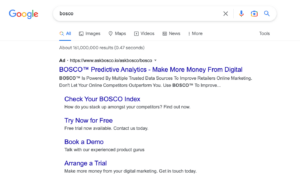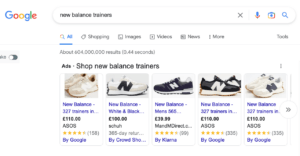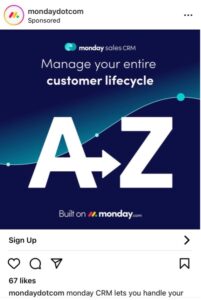Paid search and paid social are both great digital marketing methods that allow you to reach more customers and drive relevant traffic to your website. Whilst paid search includes advertising on search engine results pages (SERPs), paid social involves producing ads that will show up on a social media platform of your choice.
But which method is best suited for your business? What are the pros and cons of each? Find out more below.
Table of Contents
What is paid search?
Paid search is an advertising method that allows businesses to display their ads on search engine results pages in exchange for a fee. It is a form of digital marketing that allows the advertiser to target a specific group of users based on their search queries. Paid search is different from organic search in that it promotes ads instead of organic content.
Paid search is a form of pay-per-click marketing (PPC). Essentially, the company won’t pay anything unless someone clicks on their advert and the advert is created based on the type of search terms the user is likely to search for in relation to the product or service of interest.
Adverts can be either text-focused or shopping focused and you’ll be able to identify a paid-for ad next time you Google anything… (well, almost anything) but we’ve included some examples below for a visual.
A PPC text ad:

A PPC shopping ad:

For more information on the basics of PPC, refer to our PPC best practice guide.
Benefits of paid search:
Paid search advertising offers many benefits for brands, including:
PPC is measurable and controllable
Paid search campaigns are measurable and trackable, allowing businesses to track their progress and adjust campaigns accordingly.
PPC targets an audience that are already searching for your product or service
Through paid search ads, you have the ability to promote your brand to a relevant and engaged audience who are actively searching for the products/services you offer.
PPC offers quick results
We’re not saying it’s a quick win, because optimisation to get the advertiser where they want to be can take time, however, you can get campaigns set up relatively quickly and start driving traffic immediately through paid search.
PPC increases visibility
Paid search helps increase visibility for businesses by allowing them to place ads at the top of the search engine results pages (SERPs) so they can be seen before any organic listings.
PPC boosts brand awareness
Paid search campaigns can help increase brand awareness and bolster recognition of a business’s products and services.
PPC increases sales and revenue
By increasing the visibility and awareness of your brands and products, and driving relevant traffic to your site, paid search contributes to an increase in sales and revenue by sending interested users to your site.
Drawbacks of paid search:
Although there are many benefits on offer, there are also some drawbacks you should consider before embarking on a costly PPC campaign that might not be right for your business. The disadvantages of paid search include:
PPC can be costly
Paid search advertising can be costly, especially when bidding on competitive keywords. The cost per click (CPC) can be high, eating into your budget quickly.
PPC can be time-consuming
Managing a paid search campaigns can be time-consuming. You must research and select the right keywords, optimise your ad copy, track performance, and adjust accordingly. If you’re trying it out on your own without the help of a PPC expert, this could take you a while to figure out.
There is a risk of click fraud with PPC
Click fraud is an issue with paid search advertising. This is when bots or competitors click on your ads to increase your costs without generating any leads or sales.
PPC targeting can get complicated
It can be difficult to target the right audience with paid search advertising. You must have a well-defined target market to ensure your ads are reaching the right people.
If you’re having trouble with any of the above, drop us a message to see how our PPC experts could help you manage your paid search activity.
What is paid social?
Paid social advertising is a type of digital marketing that involves using social media platforms such as Facebook, Instagram, Twitter, LinkedIn, YouTube and TikTok to promote a business, product, or service in the form of eye-catching video and image adverts.
Paid social advertising is an effective way for businesses to reach their target audience and get the word out about their products and services. It allows businesses to create targeted campaigns that reach potential customers wherever they currently are & who are the most likely to be interested in what they have to offer.
Similar to paid search, companies running paid social ads pay for a click on their adverts or, depending on the campaign objective, could be charged per 1,000 impressions (this is how many times the ad has been seen).
According to smart insights, the number of social media users across the world grew to 4.62 billion in January 2022; so, by advertising across relevant platforms to your business you’re increasing brand awareness from the get-go. Even before driving traffic, you have the ability to put your brand and brand personality out to millions of people.
Adverts you’ll typically see on social media platforms are in video, image and carousel formats however you can create text-based ads on platforms such as Twitter. We’ve added an example of each format below:
A video ad:

An image ad:

A carousel ad:

A text ad:

Read our blog to find out more about the basics of paid social and what you need to consider when setting up your campaigns.
Benefits of paid social:
As mentioned above, the audience available to you on social media platforms is huge and continues to grow, which is one of the most obvious benefits. Aside from that, other benefits of paid social advertising include:
Paid social ads guarantee reach to new and existing audience
By breaking through organic algorithms, paying for social ads ensure your content is seen by those users you have explicitly targeted.
Paid social advertising offers A/B testing capabilities
Test out which formats work the best for your business and your audience by setting up split tests, so you don’t waste your budget on the wrong type of ad which won’t convert.
Paid social allows you to create personalised ads
You can create ads that are tailored to your target audience and customise them with visuals, text, and calls to action. This allows you to appeal to a more engaged audience and increase the chances of them taking action.
Paid social ads build brand awareness across new customers
By using targeted ads, you can reach potential customers who may not have been aware of your business before. This is especially beneficial for businesses that are just starting out and need to get the word out
Paid social is cost effective
Paid social advertising is highly cost-effective. You only pay for the ads when someone takes action, such as clicking on a link or visiting your website. You can also closely track the results of your campaigns and adjust your strategy accordingly, making it much more affordable than other forms of advertising where you pay a set price to run ads.
Drawbacks of paid social:
While paid social advertising can be effective in reaching a larger audience, there are a few drawbacks to consider before committing to this type of marketing.
Paid social can be costly
Although some see paid social advertising as cost-effective, as mentioned above, the cost of social ads can be a disadvantage for some businesses, especially smaller ones. Social media platforms charge fees for advertising campaigns, and these fees can be quite expensive. Depending on the size and scope of the campaign, the costs can quickly add up.
There can be a lack of creative control with paid social ads
Social media platforms typically have their own rules and guidelines for advertising, which can limit the creativity of the ad. For example, the ad may need to be in a certain format or be limited to a certain number of words or images. This can make it difficult for businesses to create effective, eye-catching ads.
Paid social advertising can be difficult to measure
It can be difficult to determine which ads are generating the most clicks and impressions, and what the return on investment is for each ad. This makes it difficult to make any adjustments to the campaign and optimise the budget. Read our guide to find out the best paid social KPIs to track to measure the success of your campaigns.
If you’re facing any of the issues above, contact our paid social experts for some advice.
Difference between paid search and paid social:
Paid social differs slightly from paid search in that rather than targeting a potential customer based on keywords which the audience is actively searching for, targeting is based on the audience’s interests, behaviours, and demographics.
Having said this, with channels like Twitter and Pinterest there is an element of keyword targeting where you can apply a list of terms your audience is likely to search for on these platforms during the research and inspiration phase of their buying journey.
Another major difference is that paid search ads are generally a more receptive strategy as they are served to users that are explicitly searching for related terms to your products or services, whereas paid social ads are more pre-emptive, to promote your brand to users that could be interested in your products or services based on their past behaviour on the platform.
Unlike paid search, paid social is generally very visual and highly engaging creatives are of utmost importance to driving performance. Whilst paid search is moving into a more visual space, with the introduction of performance max campaigns which allow the advertiser to appear on the display network and YouTube, more conventionally, the ads are text or shopping based.
Which is better for your brand – paid search or paid social?
Which paid advertising method is best for you is ultimately dependent on your available budget and business goals. But the best scenario is a mixture of both. By advertising across both search engines and social media platforms, you have more opportunity to reach a larger audience, however, this won’t be feasible for all businesses.
Whilst paid social ads are better for users in an earlier stage of the buying journey, capturing them when they aren’t necessarily expecting it to build their awareness and consideration, paid search ads are generally best to target users near the end of their journey, just as they’re ready to purchase.
Typically, you’ll see immediate results in terms of website traffic and clicks from paid search, but social ads are far more visually appealing, great for building brand awareness and capturing new groups of consumers you have specified.
Without truly understanding the company, the sector, the competition, the creative capabilities and the USPs, it is difficult to say which is best for your brand. If you’re unsure which channel would work best for your business, get in touch with our experts who can help you with PPC and paid social advertising.






